Ultrafast Optical Signal Processing with Bragg Structures
Abstract
:1. Introduction
2. The Bragg-Grating (BG) Structure
3. Optical Signal Processing in Resonantly Absorbing Bragg Reflector (RABR)
3.1. Theoretical Considerations
3.2. Experimental Work on RABR
4. Optical Signal Processing in Chirped Bragg Structures
- (i)
- At low intensities, e.g., 0.65 GW/cm2, the pulse is almost totally reflected by the Bragg structure due to the presence of the photonic bandgap (Figure 6bd1). Since the pulse’s dispersion is not compensated by the weak nonlinearity, pulse stretching is observed.
- (ii)
- At higher intensities, an unstable standing light pulse trapped at the interface is generated. In particular, at = 2.26 GW/cm2, the pulse will be reflected after stopping for a short time, as seen in panel (d2) of Figure 6b. Slightly increasing to 2.29 GW/cm2, in the range of 2.26 to 2.29 GW/cm2, gives rise to a stopping time of ~1.3 ns for the pulse that is eventually reflected, as shown in panel (d3).
- (iii)
- A slow moving Bragg soliton can be observed, as shown in panel (d4), for IP = 2.30 GW/cm2. In this case, the velocity of the pulse is equal to 0.005 c. Further simulations demonstrate that the velocity of the moving soliton increases with a further increase of IP.
5. Ultrafast Pulse Modulations Based on Cholesteric Liquid Crystal (CLCs) Bragg Gratings
6. Conclusions
Acknowledgments
Author Contributions
Conflicts of Interest
References
- Hau, L.V.; Harris, S.E.; Dutton, Z.; Behroozi, C.H. Light speed reduction to 17 metres pe rsecond in an ultra cold atomic gas. Nature 1999, 397, 594–598. [Google Scholar] [CrossRef]
- Liu, C.; Dutton, Z.; Behroozi, C.H.; Hau, L.V. Observation of coherent optical information storage in an atomic medium using halted light pulses. Nature 2001, 409, 490–493. [Google Scholar] [CrossRef] [PubMed]
- Song, K.Y.; Herraez, M.G.; Thevenaz, L. Observation of pulse delaying and advancement in optical fibers using stimulated Brillouin scattering. Opt. Express 2005, 13, 82–88. [Google Scholar] [CrossRef] [PubMed]
- BaBa, T. Slow light in photonic crystals. Nat. Photonic 2008, 2, 465–473. [Google Scholar] [CrossRef]
- Li, J.T.; White, T.P.; O’Faolain, L.; Gomez-Iglesias, A.; Krauss, T.F. Systematic design of flat band slow light in photonic crystal waveguides. Opt. Express 2008, 16, 6227–6232. [Google Scholar] [CrossRef] [PubMed]
- Li, J.; O’Faolain, L.; Schulz, S.A.; Krauss, T.F. Low loss propagation in slow light photonic crystal waveguides at group indices up to 60. Hydrometallurgy 2012, 10, 589–593. [Google Scholar] [CrossRef]
- Li, J.T.; Zhou, J.Y. Nonlinear optical frequency conversion with stopped short light pulses. Opt. Express 2006, 14, 2811–2816. [Google Scholar] [CrossRef] [PubMed]
- Li, J.; O’Faolain, L.; Krauss, T.F. Four-wave mixing in slow light photonic crystal waveguides with very high group index. Opt. Express 2012, 20, 17474–17479. [Google Scholar] [CrossRef] [PubMed]
- Kozhekin, A.; Kurizki, G. Self-induced transparency in Bragg Reflectors: Gap Solitons near absorption resonances. Phys. Rev. Lett. 1995, 74, 5020–5023. [Google Scholar] [CrossRef] [PubMed]
- Kozhekin, A.; Kurizki, G.; Malomed, B. Standing and moving gap solitons in resonantly absorbing gratings. Phys. Rev. Lett. 1998, 81, 3647–3650. [Google Scholar] [CrossRef]
- Opatrny, T.; Kurizki, G.; Malomed, B. Dark and bright solitons in resonantly absorbing gratings. Phys. Rev. E 1999, 60, 6137–6149. [Google Scholar] [CrossRef]
- Xiao, W.N.; Zhou, J.Y.; Prineas, J.P. Storage of ultrashort optical pulses in a resonantly absorbing Bragg reflector. Opt. Express 2003, 11, 3277–3283. [Google Scholar] [CrossRef] [PubMed]
- Zhou, J.Y.; Shao, H.G.; Zhao, J.; Yu, X.; Wong, K.S. Storage and release of femtosecond laser pulses in a resonant photonic crystal. Opt. Lett. 2005, 30, 1560–1562. [Google Scholar] [CrossRef] [PubMed]
- Fu, S.; Liu, Y.; Li, Y.; Song, L.; Li, J.; Malomed, B.A.; Zhou, J. Buffering and trapping ultrashort optical pulses in concatenated Bragg gratings. Opt. Lett. 2013, 38, 5047–5050. [Google Scholar] [CrossRef] [PubMed]
- Fu, S.; Li, Y.; Liu, Y.; Zhou, J.; Malomed, B.A. Tunable storage of optical pulses in a tailored Bragg-grating structure. J. Opt. Soc. Am. 2015, 32, 534–539. [Google Scholar] [CrossRef]
- Deng, Z.; Lin, H.; Li, H.; Fu, S.; Liu, Y.; Xiang, Y.; Li, Y. Femtosecond soliton diode on heterojunction Bragg-grating structure. Appl. Phys. Lett. 2016, 109, 121101. [Google Scholar] [CrossRef]
- Song, L.; Fu, S.; Liu, Y.; Zhou, J.; Chigrinov, V.G.; Khoo, I.C. Direct femtosecond pulse compression with miniature-sized Bragg cholesteric liquid crystals. Opt. Lett. 2013, 38, 5040–5042. [Google Scholar] [CrossRef] [PubMed]
- Liu, Y.; Wu, Y.; Chen, C.W.; Zhou, J.; Lin, T.H.; Khoo, I.C. Ultrafast pulse compression, stretching-and-recompression using cholesteric liquid crystals. Opt. Express 2016, 24, 10458. [Google Scholar] [CrossRef] [PubMed]
- John, S. Strong localization of photons in certain disordered dielectric superlattices. Phys. Rev. Lett. 1987, 58, 2486–2489. [Google Scholar] [CrossRef] [PubMed]
- Yablonovitch, E. Inhibited Spontaneous emission in solid-state physics and electronics. Phys. Rev. Lett. 1987, 58, 2059–2062. [Google Scholar] [CrossRef] [PubMed]
- Vlasov, Y.A.; O’Boyle, M.; Hamann, H.F.; McNab, S.J. Active control of slow light on a chip with photonic crystal waveguides. Nature 2005, 438, 65–69. [Google Scholar] [CrossRef] [PubMed]
- Frandsen, L.H.; Lavrinenko, A.V.; Fage-Pedersen, J.; Borel, P.I. Photonic crystal waveguides with semi-slow light and tailored dispersion properties. Opt. Express 2006, 14, 9444–9450. [Google Scholar] [CrossRef] [PubMed]
- Hill, K.O.; Malo, B.; Bilodeau, R.; Johnson, D.C.; Albert, J. Bragg gratings fabricated in monomode photosensitive optical fiber by UV exposure through a phase mask. Appl. Phys. Lett. 1993, 62, 1035. [Google Scholar] [CrossRef]
- Patrick, H.J.; Williams, G.M.; Kersey, A.D.; Pedrazzani, J.R.; Vengsarkar, A.M. Hybrid fiber Bragg grating/long period fiber grating sensor for strain/temperature discrimination. IEEE Photonics Technol. Lett. 1996, 8, 1223–1225. [Google Scholar] [CrossRef]
- Hill, K.O.; Meltz, G. Fiber Bragg grating technology fundamentals and overview. J. Light. Technol. 1997, 15, 1263–1276. [Google Scholar] [CrossRef]
- Agrawal, G.P. Nonlinear Fiber Optics; Academic Press: Waltham, MA, USA, 2007. [Google Scholar]
- Sankey, N.D.; Prelewitz, D.F.; Brown, T.G. All-optical switching in a nonlinear periodic-waveguide structure. Appl. Phys. Lett. 1992, 60, 1427–1429. [Google Scholar] [CrossRef]
- Millar, P.; De La Rue, R.M.; Krauss, T.F.; Aitchison, J.S.; Broderick, N.G.R.; Richardson, D.J. Nonlinear propagation effects in an AlGaAs Bragg grating filter. Opt. Lett. 1999, 24, 685–687. [Google Scholar] [CrossRef] [PubMed]
- Scalora, M.; Dowling, J.P.; Bowden, C.M.; Bloemer, M.J. Optical limiting and switching of ultrashort pulses in nonlinear photonic band gap materials. Phys. Rev. Lett. 1994, 73, 1368–1371. [Google Scholar] [CrossRef] [PubMed]
- Chilaya, G.S. Light-controlled change in the helical pitch and broadband tunable cholesteric liquid-crystals lase. Crystallogr. Rep. 2006, 51, S108–S118. [Google Scholar] [CrossRef]
- Moreira, M.F.; Carvalho, I.C.; Cao, W.; Bailey, C.; Taheri, B. Cholesteric liquid-crystal laser as an optic fiber-based temperature sensor. Appl. Phys. Lett. 2004, 85, 2691–2693. [Google Scholar] [CrossRef]
- Mantsyzov, B.I.; Kuz’min, R.N. Coherent interaction of light with a discrete periodic resonant medium. Sov. Phys. JETP 1986, 64, 37–44. [Google Scholar]
- Conti, C.; Assanto, G.; Trillo, S. Self-sustained trapping mechanism of zero- velocity parametric gap solitons. Phys. Rev. E 1999, 59, 2467–2470. [Google Scholar] [CrossRef]
- Rossi, A.D.; Conti, C.; Trillo, S. Stability, multistability, and wobbling of optical gap solitons. Phys. Rev. Lett. 1998, 81, 85–88. [Google Scholar] [CrossRef]
- Mantsyzov, B.I. Gap 2π pulse with an inhomogeneously broadened line and an oscillating solitary wave. Phys. Rev. E 1995, 51, 4939–4943. [Google Scholar] [CrossRef]
- Mak, W.C.K.; Malomed, B.A.; Chu, P.L. Slowdown and splitting of gap solitons in apodized Bragg gratings. J. Mod. Opt. 2004, 51, 2141–2158. [Google Scholar] [CrossRef]
- Eggleton, B.J.; Slusher, R.E.; Sterke, C.M.; Krug, P.A.; Sipe, J.E. Bragg grating solitons. Phys. Rev. Lett. 1996, 76, 1627–1630. [Google Scholar] [CrossRef] [PubMed]
- Mok, J.T.; de Sterke, C.M.; Littler, I.C.M.; Eggleton, B.J. Dispersionless slow light using gap solitons. Nat. Phys. 2006, 2, 775–780. [Google Scholar] [CrossRef]
- Goodman, R.H.; Slusher, R.E.; Weinstein, M.I. Stopping light on a defect. J. Opt. Soc. Am. B 2002, 19, 1635–1652. [Google Scholar] [CrossRef]
- Mak, W.C.K.; Malomed, B.A.; Chu, P.L. Interaction of a soliton with a local defect in a fiber Bragg grating. J. Opt. Soc. Am. B 2003, 20, 725–735. [Google Scholar] [CrossRef]
- Kurizki, G.; Kozhekin, A.E.; Opatrny, T.; Malomed, B.A. Optical solitons in periodic media with resonant and off-resonant nonlinearities. Prog. Opt. 2001, 42, 93–146. [Google Scholar]
- Mak, W.C.K.; Malomed, B.A.; Chu, P.L. Formation of a standing-light pulse through collision of gap solitons. Phys. Rev. E 2003, 68, 026609. [Google Scholar] [CrossRef] [PubMed]
- Zhou, J.; Zeng, J.; Li, J. Quantum coherent control of ultrashort laser pulses. Chin. Sci. Bull. 2008, 53, 652–658. [Google Scholar] [CrossRef]
- McCall, S.L.; Hahn, E.L. Self-induced transparency. Phys. Rev. 1969, 183, 457–485. [Google Scholar] [CrossRef]
- McCall, S.L.; Hahn, E.L. Pulse-area-pulse-energy description of a traveling-wave laser amplifier. Phys. Rev. A 1970, 2, 861–870. [Google Scholar] [CrossRef]
- Mantsyzov, B.I.; Silnikov, R.A. Unstable excited and stable oscillating gap 2π pulses. J. Opt. Soc. Am. B 2002, 19, 2203–2207. [Google Scholar] [CrossRef]
- Shen, Y.R. The Principles of Nonlinear Optics; Wiley-Interscience: New York, NY, USA, 1984. [Google Scholar]
- Prineas, J.P.; Ell, C.; Lee, E.S.; Khitrova, G.; Gibbs, H.M.; Koch, S.W. Exciton-polariton eigenmodes in light-coupled In0.04Ga0.96As/GaAs semiconductor multiple-quantum-well periodic structures. Phys. Rev. B 2000, 61, 13863–13872. [Google Scholar] [CrossRef]
- Zhao, J.; Li, J.T.; Shao, H.G.; Wu, J.; Zhou, J.; Wong, K.S. Reshaping ultrashort light pulses in resonant photonic crystals. J. Opt. Soc. Am. B 2006, 23, 1981–1987. [Google Scholar] [CrossRef]
- Zhao, J.; Lan, Q.; Zhang, J.; LI, J.; Zeng, J.; Cheng, J.; Friedler, I.; Kurizki, G. Nonlinear dynamics of negatively refracted light in a resonantly absorbing Bragg reflectors. Opt. Lett. 2007, 32, 1117–1119. [Google Scholar] [CrossRef]
- Shao, H.G.; Zhao, J.; Wu, J.W.; Zhou, J. Moving and zero-velocity gap soliton in resonantly absorbing Bragg reflector of finite atomic widths. Acta Phys. Sin. 2005, 54, 1420–1425. [Google Scholar]
- Prineas, J.P.; Zhou, J.Y.; Kuhl, J.; Gibbs, H.M.; Khitrova, G.; Koch, S.W.; Knorr, A. Ultrafast ac Stark effect switching of the active photonic band gap from Bragg-periodic semiconductor quantum wells. Appl. Phys. Lett. 2002, 81, 4332–4334. [Google Scholar] [CrossRef]
- De Sterke, C.M.; Sipe, J.E. Gap solitons. Prog. Opt. 1994, 33, 203–260. [Google Scholar]
- Eggleton, B.J.; de Sterke, C.M.; Slusher, R.E. Nonlinear pulse propagation in Bragg gratings. J. Opt. Soc. Am. B 1997, 14, 2980–2993. [Google Scholar] [CrossRef]
- Shnaiderman, R.; Tasgal, R.S.; Band, Y.B. Creating very slow optical gap solitons with a grating-assisted coupler. Opt. Lett. 2011, 36, 2438–2440. [Google Scholar] [CrossRef] [PubMed]
- Poladian, L. Graphical and WKB analysis of non-uniform Bragg gratings. Phys. Rev. E 1993, 48, 4758. [Google Scholar] [CrossRef]
- Tsoy, E.N.; de Sterke, C.M. Propagation of nonlinear pulses in chirped fiber gratings. Phys. Rev. E 2000, 62, 2882. [Google Scholar] [CrossRef]
- Janner, D.; Galzerano, G.; Valle, G.D.; Laporta, P.; Longhi, S. Slow light in periodic superstructure Bragg gratings. Phys. Rev. E 2005, 72, 056605. [Google Scholar] [CrossRef] [PubMed]
- Yu, M.; Wang, L.; Nemati, H.; Yang, H.; Bunning, T.; Yang, D.K. Effects of polymer network on electrically induced reflection band broadening of cholesteric liquid crystals. J. Polym. Sci. Part B Polym. Phys. 2017. [Google Scholar] [CrossRef]
- Broderick, N.G.R.; Taverner, D.; Richardson, D.J.; Ibsen, M.; Laming, R.I. Optical pulse compression in fiber Bragg gratings. Phys. Rev. Lett. 1997, 79, 4566. [Google Scholar] [CrossRef]
- Khoo, I.C. Nonlinear optics, active plasmonics and metamaterials with liquid crystals. Prog. Quant. Electron. 2014, 38, 77–117. [Google Scholar] [CrossRef]
- Khoo, I.C. Nonlinear optics of liquid crystalline materials. Phys. Rep. 2009, 471, 221–267. [Google Scholar] [CrossRef]
- Khoo, I.C.; Webster, S.; Kubo, S.; Youngblood, W.J.; Liou, J.D.; Mallouk, T.E.; Lin, P.; Haganb, D.J.; Strylandb, E.W.V. Synthesis and characterization of the multi-photon absorption and excited-state properties of a neat liquid 4-propyl 4'-butyl diphenyl acetylene. J. Mat. Chem. 2009, 19, 7525–7531. [Google Scholar] [CrossRef]
- Khoo, I.C. Nonlinear Organic Liquid Cored Fiber Array for All- Optical Switching and Sensor Protection against Short Pulsed Lasers. IEEE J. Sel. Top. Quantum Electron. 2008, 14, 946–951. [Google Scholar] [CrossRef]
- Khoo, I.C.; Diaz, A. Multiple-time-scale dynamic studies of nonlinear transmission of pulsed lasers in a multiphoton-absorbing organic material. J. Opt. Soc. Am. B 2011, 28, 1702–1710. [Google Scholar] [CrossRef]
- Hwang, J.; Ha, N.Y.; Chang, H. J.; Park, B.; Wu, J.W. Enhanced optical nonlinearity near the photonic bandgap edges of a cholesteric liquid crystal. Opt. Lett. 2004, 29, 2644–2646. [Google Scholar] [CrossRef] [PubMed]
- Hwang, J.; Wu, J.W. Determination of optical Kerr nonlinearity of a photonic bandgap structure by Z-scan measurement. Opt. Lett. 2005, 30, 875–877. [Google Scholar] [CrossRef] [PubMed]
- Ha, N.Y.; Ohtsuka, Y.; Jeong, S.M.; Nishimura, S.; Suzaki, G.; Takanishi, Y.; Ishikawa, K.; Takezoe, H. Fabrication of a simultaneous red–green–blue reflector using single-pitched cholesteric liquid crystals. Nat. Mater. 2008, 7, 43–47. [Google Scholar] [CrossRef] [PubMed]
- White, T.J.; Bricker, R.L.; Natarajan, L.V.; Tabiryan, N.V.; Green, L.; Li, Q.; Bunning, T.J. Phototunable azobenzene cholesteric liquid crystals with 2000 nm range. Adv. Funct. Mater. 2009, 19, 3484–3488. [Google Scholar] [CrossRef]
- Christodoulides, D.N.; Khoo, I.C.; Salamo, G.J.; Stegeman, G.I.; Stryland, E.W.V. Nonlinear refraction and absorption: Mechanisms and magnitudes. Adv. Opt. Photonics 2010, 2, 60–200. [Google Scholar] [CrossRef]
- Maine, P.; Strickland, D.; Bado, P.; Pessot, M.; Mourou, G. Generation of ultrahigh peak power pulses by chirped pulse amplification. IEEE J. Quantum Electron. 1988, 24, 398–403. [Google Scholar] [CrossRef]
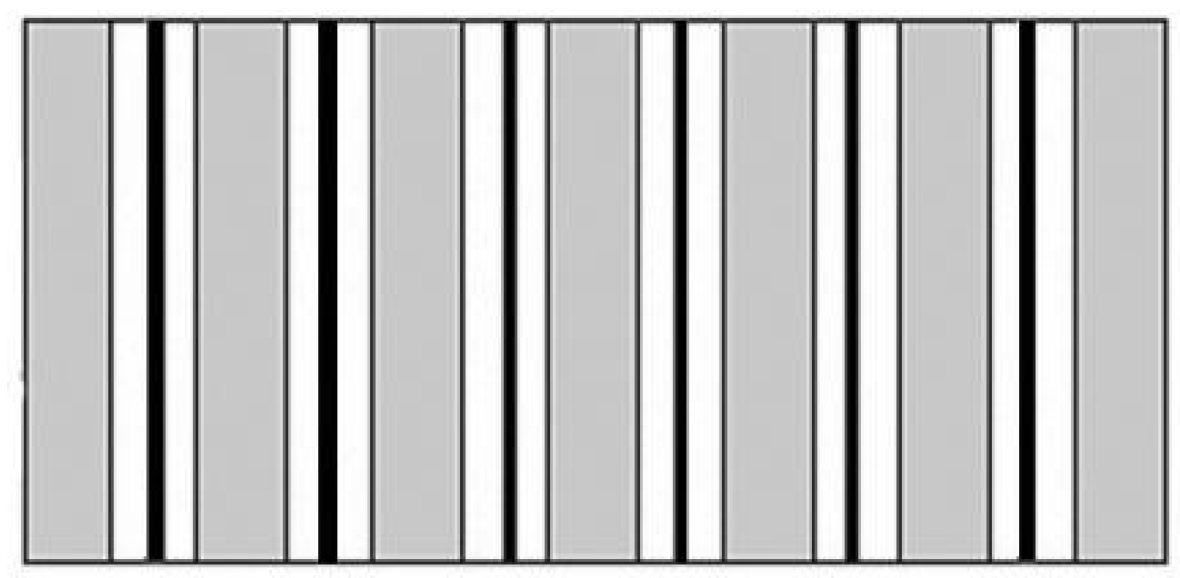



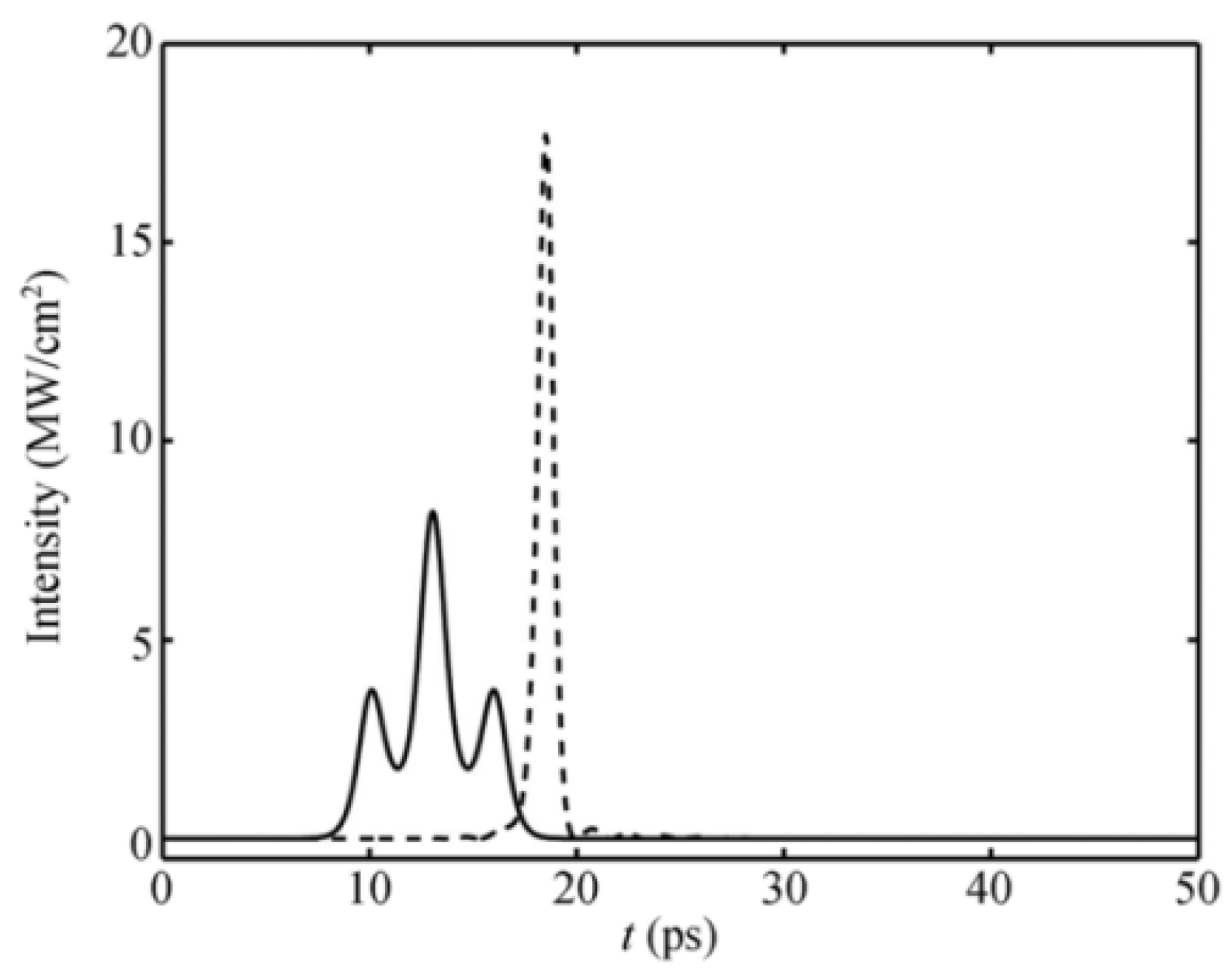

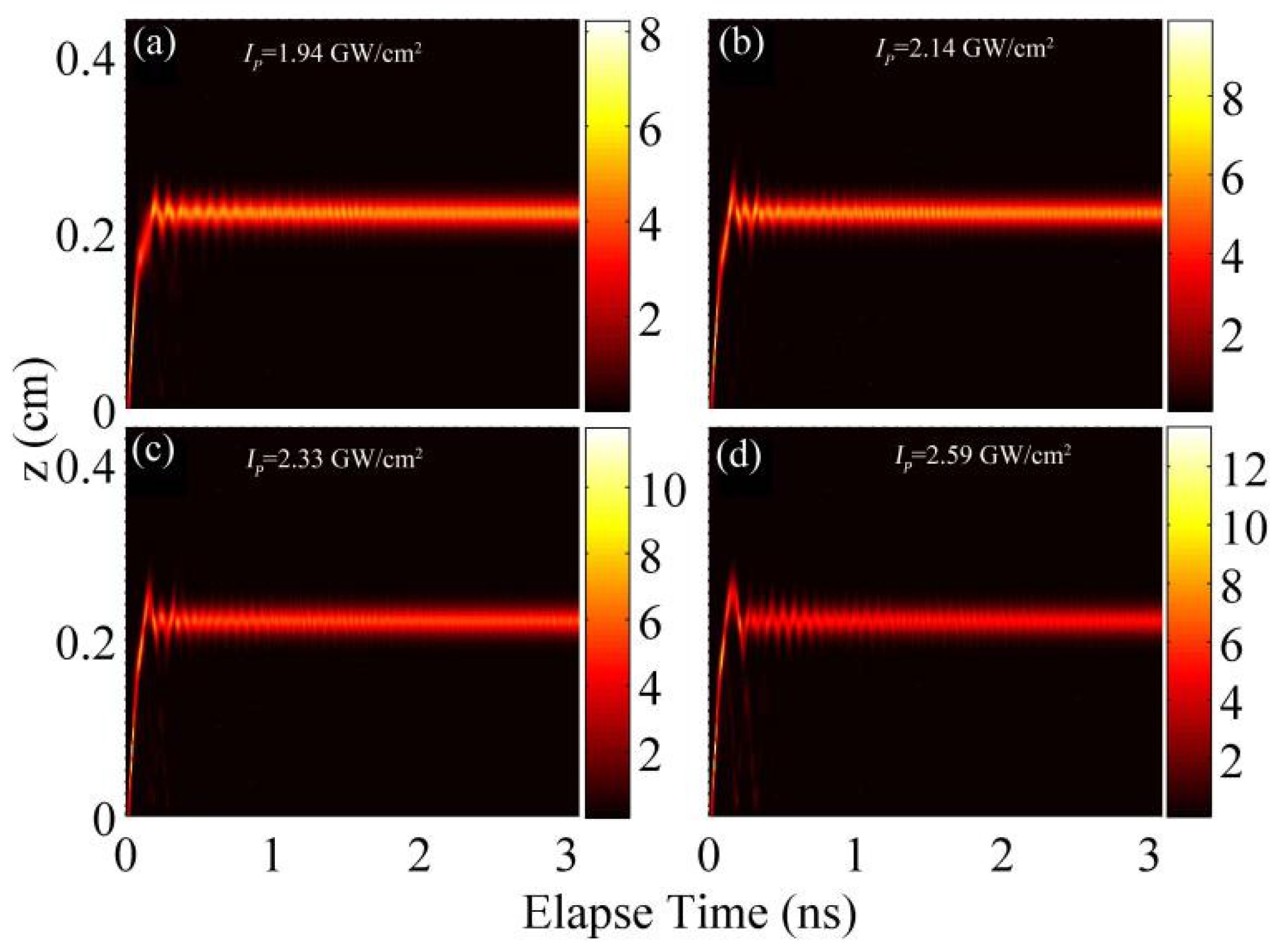
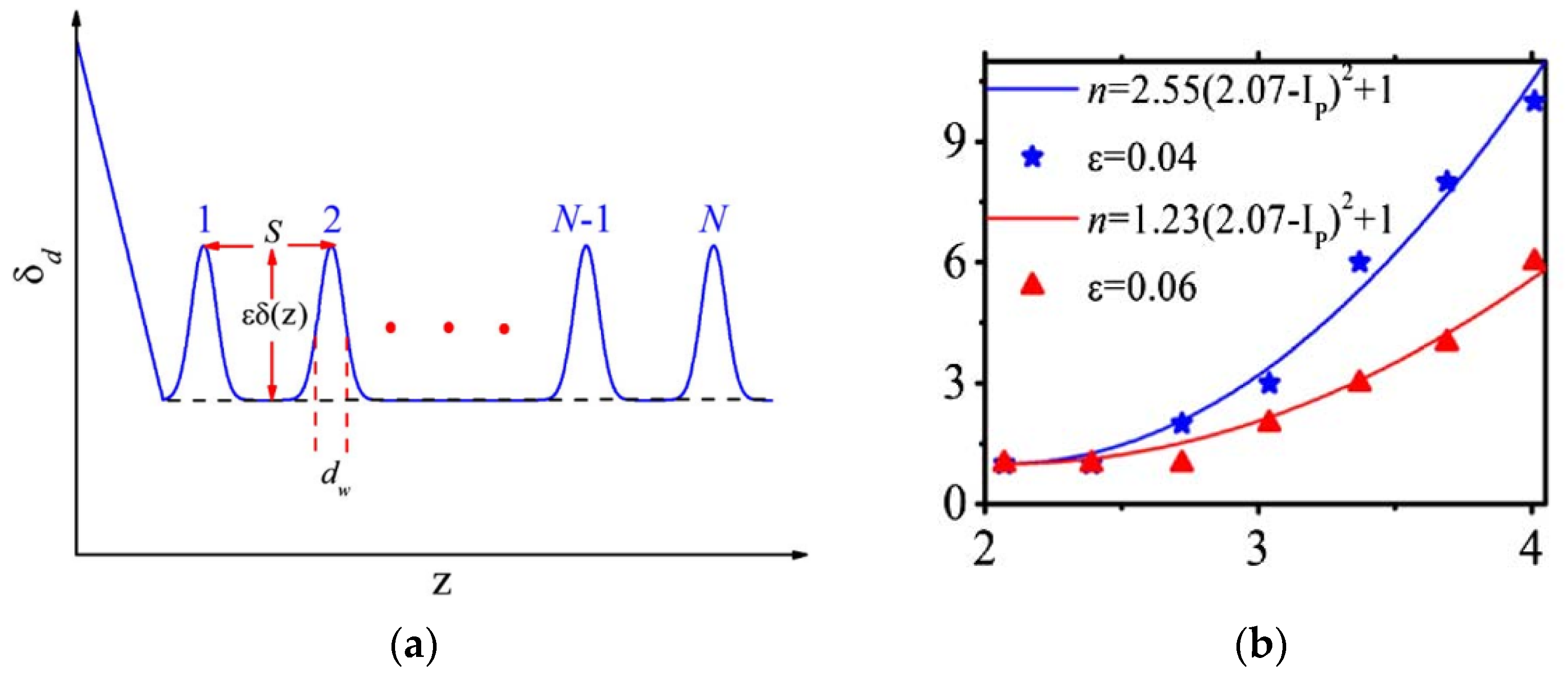
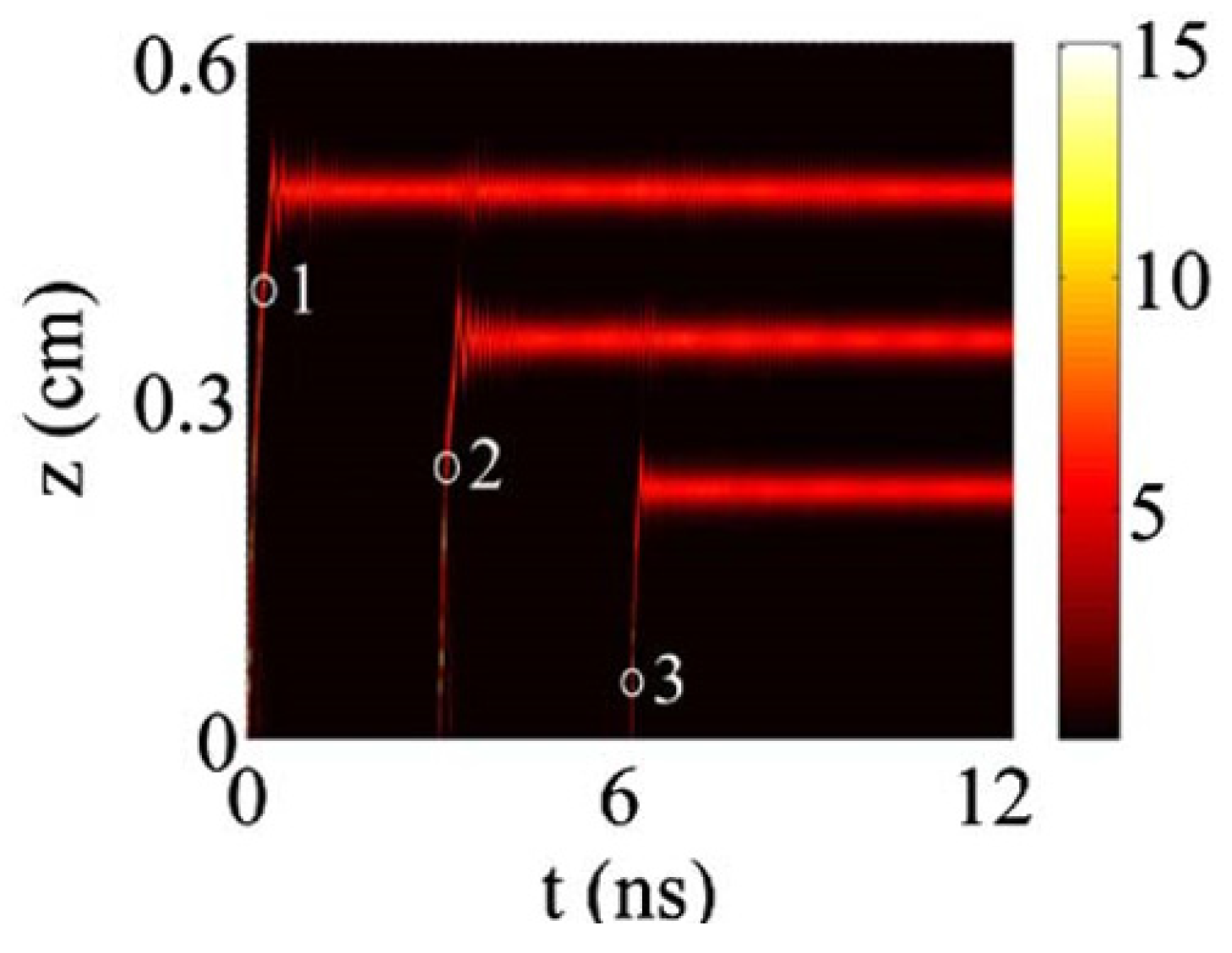
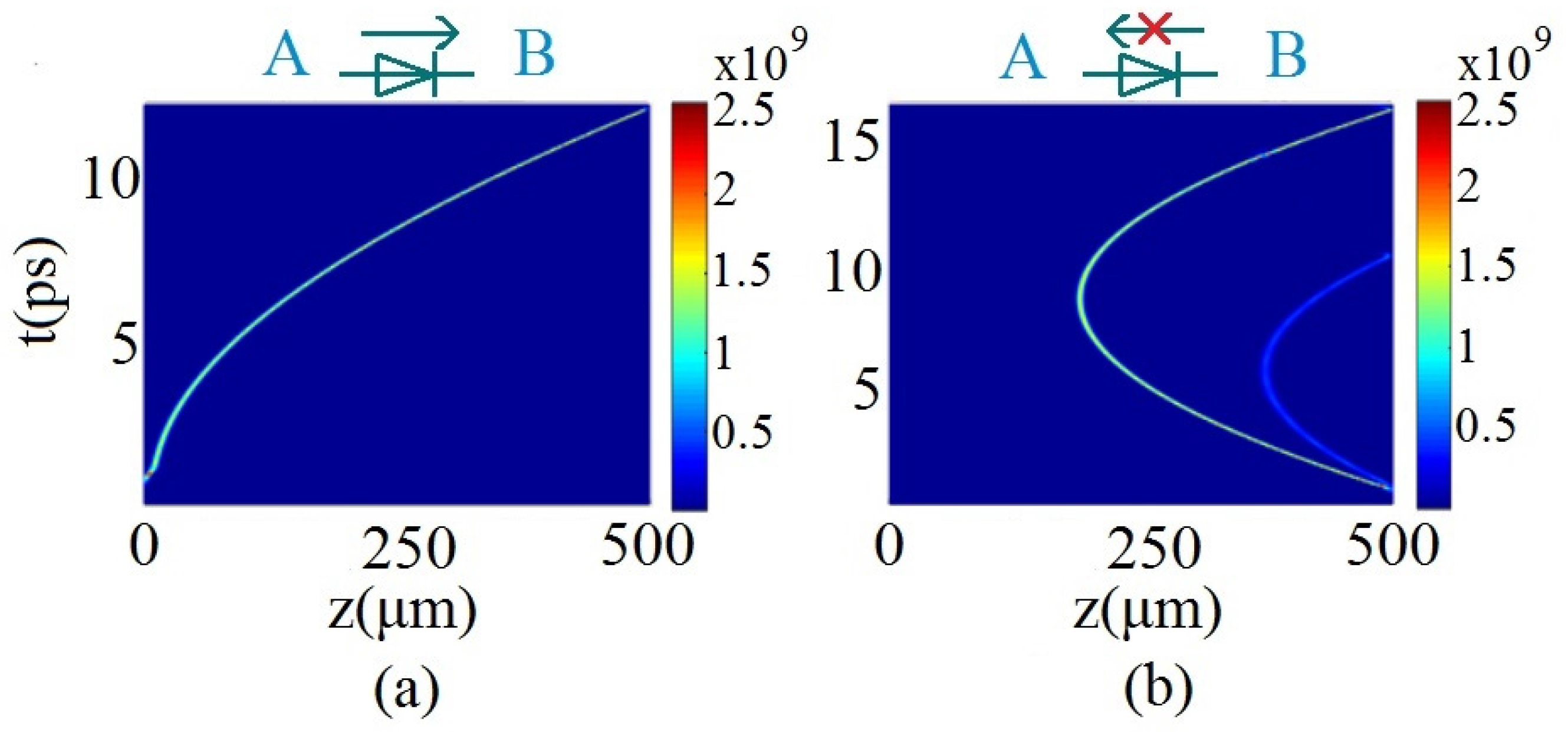
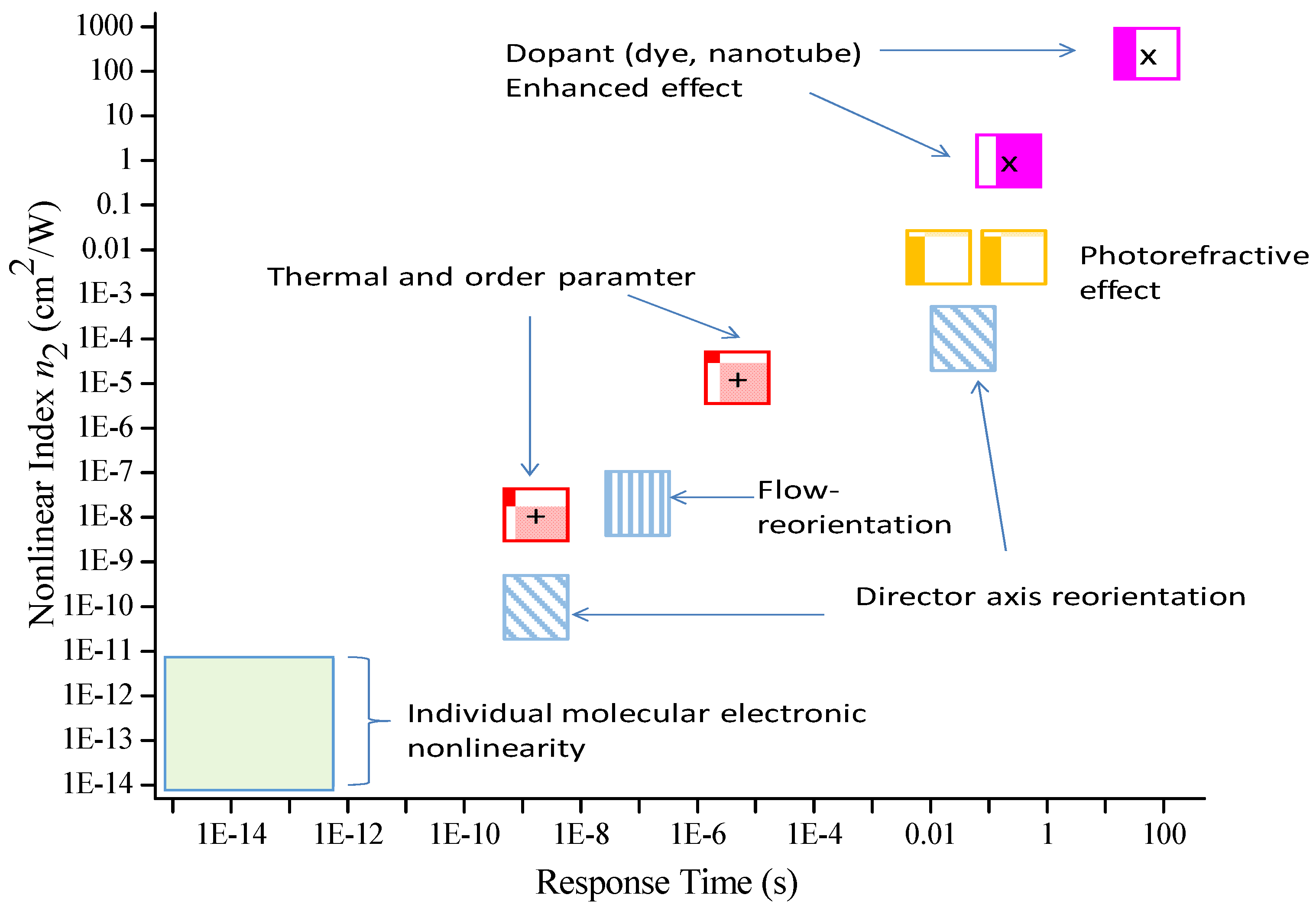
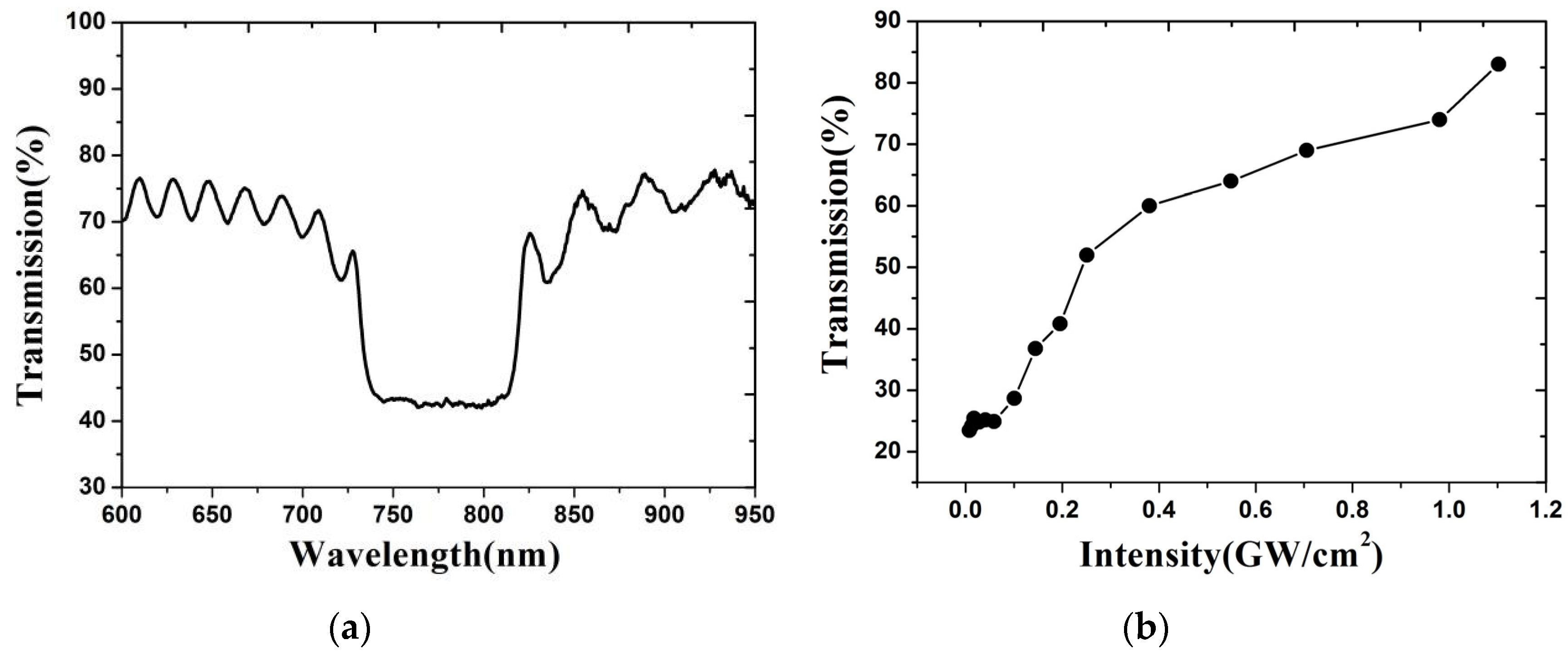
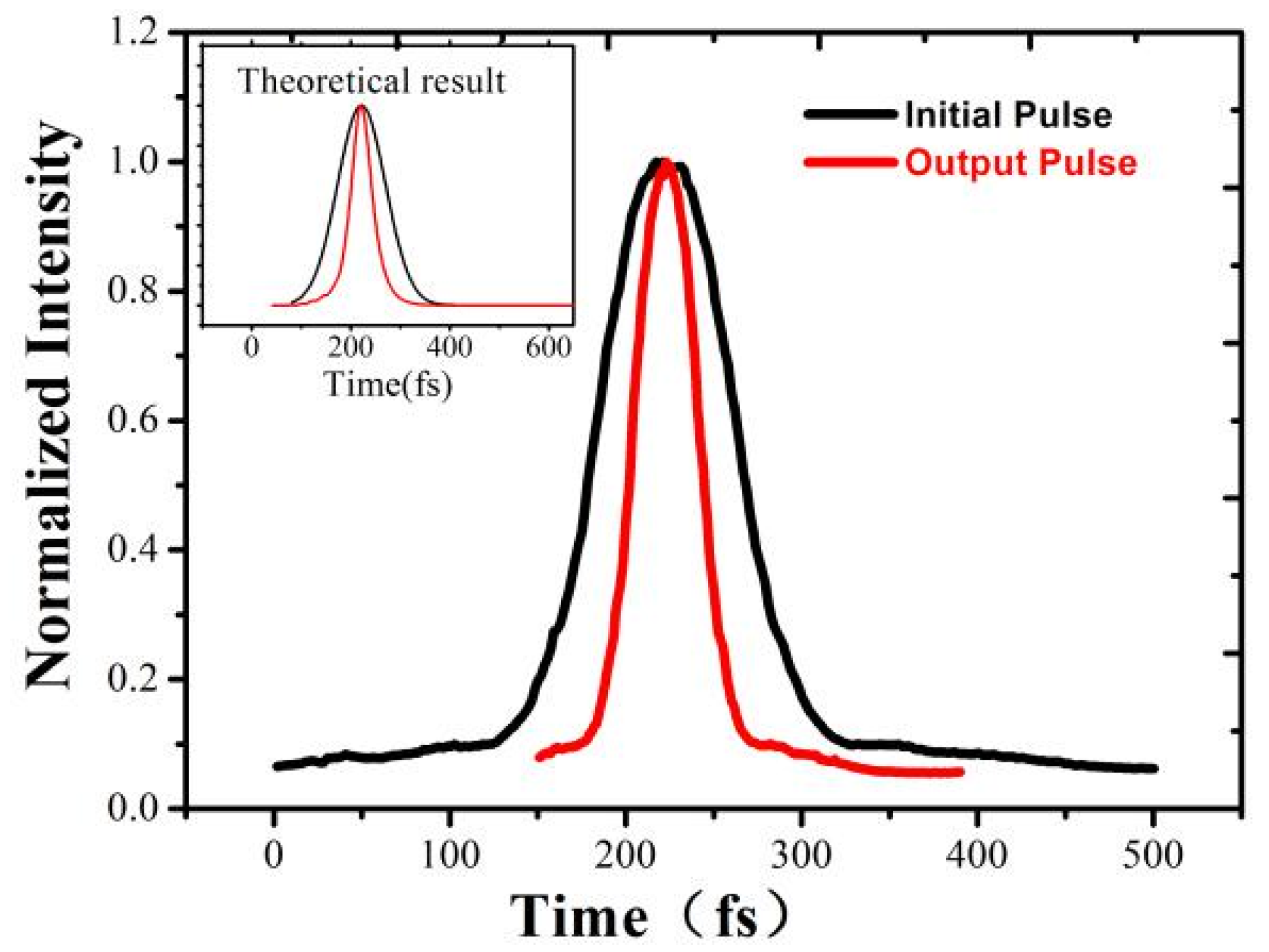
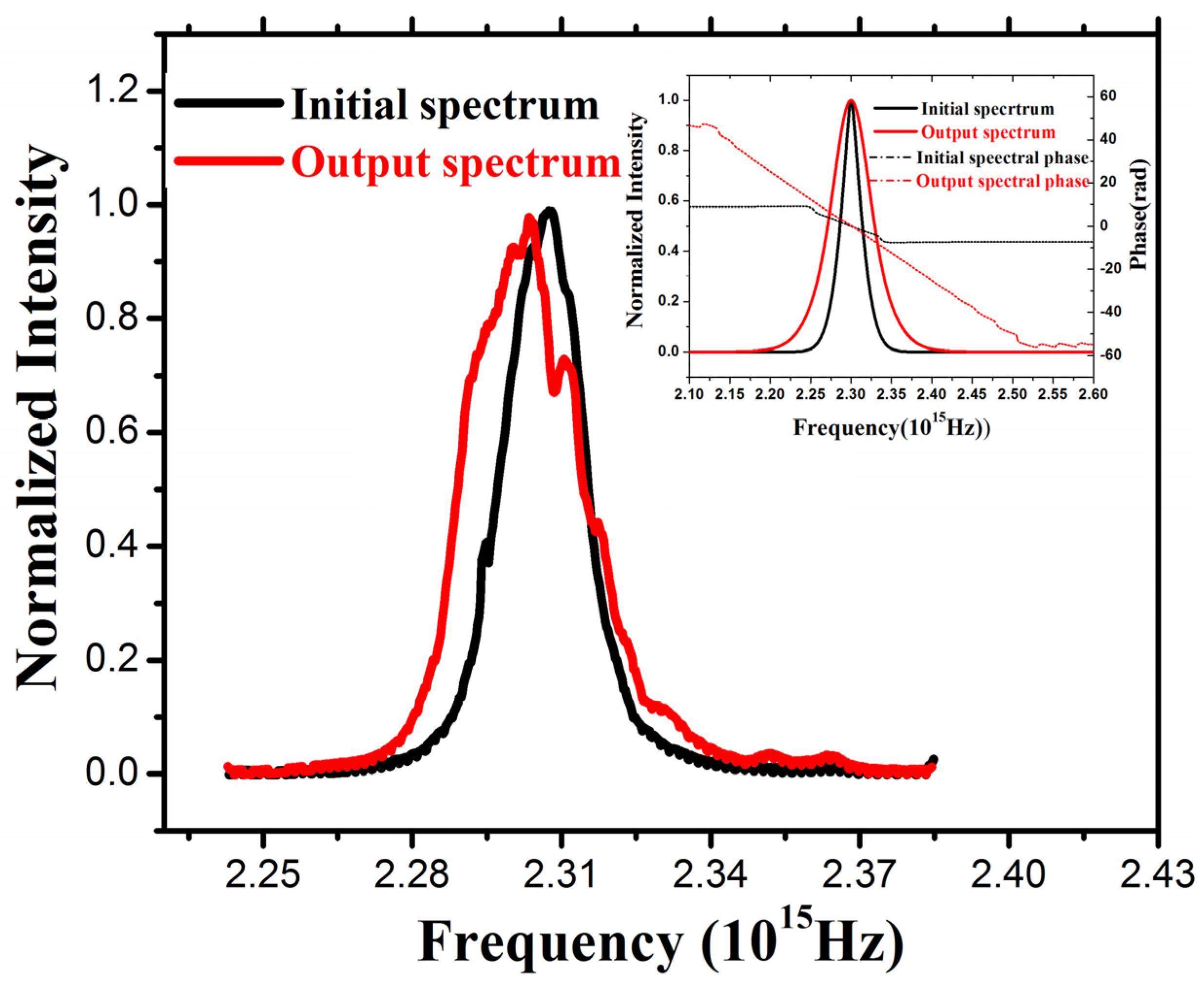
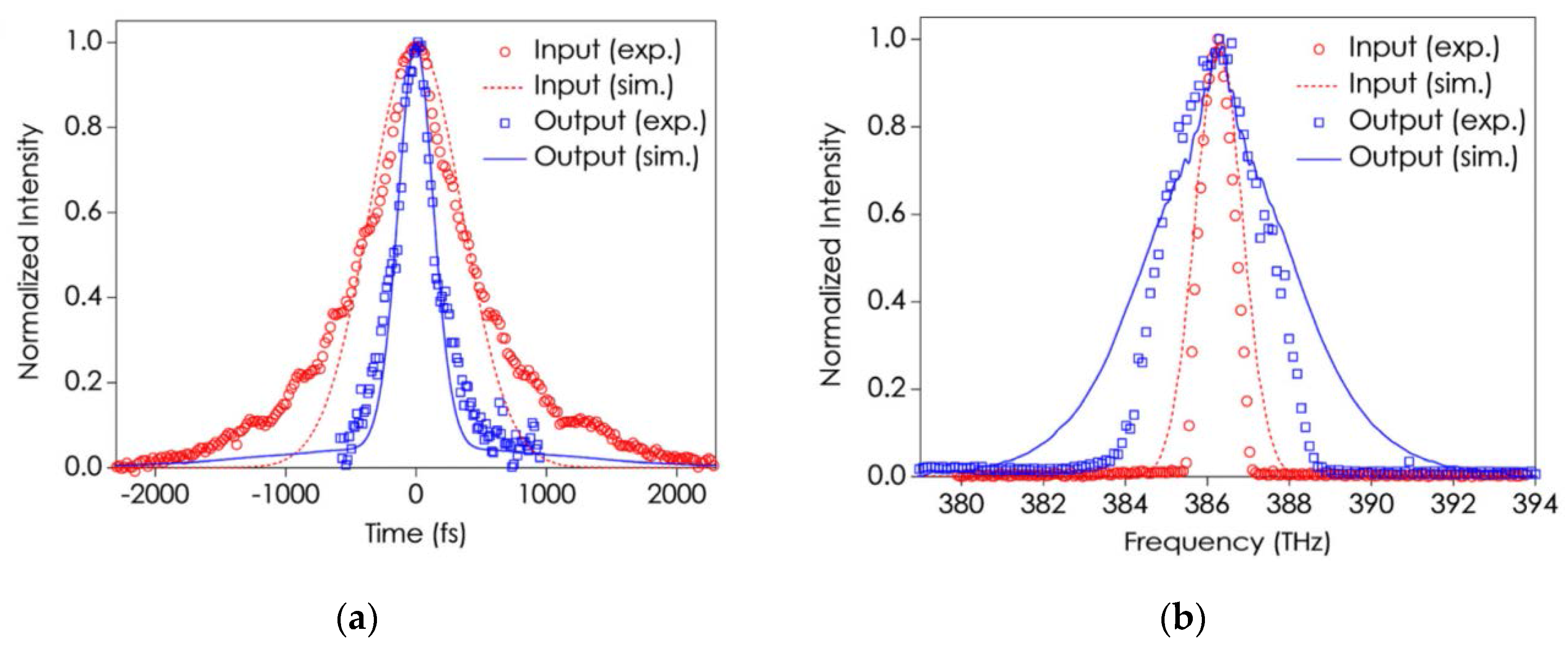
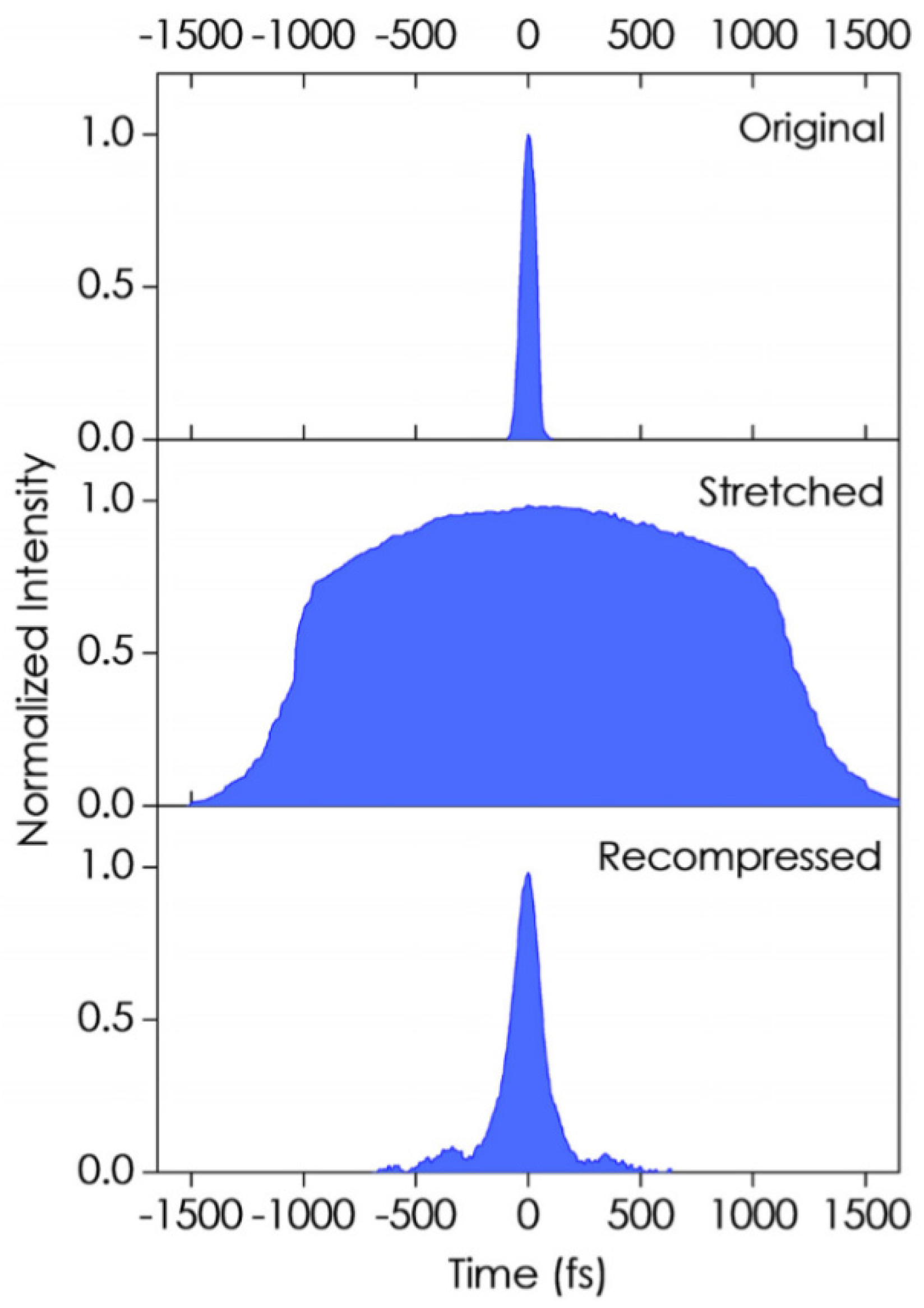
© 2017 by the authors. Licensee MDPI, Basel, Switzerland. This article is an open access article distributed under the terms and conditions of the Creative Commons Attribution (CC BY) license (http://creativecommons.org/licenses/by/4.0/).
Share and Cite
Liu, Y.; Fu, S.; Malomed, B.A.; Khoo, I.C.; Zhou, J. Ultrafast Optical Signal Processing with Bragg Structures. Appl. Sci. 2017, 7, 556. https://doi.org/10.3390/app7060556
Liu Y, Fu S, Malomed BA, Khoo IC, Zhou J. Ultrafast Optical Signal Processing with Bragg Structures. Applied Sciences. 2017; 7(6):556. https://doi.org/10.3390/app7060556
Chicago/Turabian StyleLiu, Yikun, Shenhe Fu, Boris A. Malomed, Iam Choon Khoo, and Jianying Zhou. 2017. "Ultrafast Optical Signal Processing with Bragg Structures" Applied Sciences 7, no. 6: 556. https://doi.org/10.3390/app7060556
APA StyleLiu, Y., Fu, S., Malomed, B. A., Khoo, I. C., & Zhou, J. (2017). Ultrafast Optical Signal Processing with Bragg Structures. Applied Sciences, 7(6), 556. https://doi.org/10.3390/app7060556







